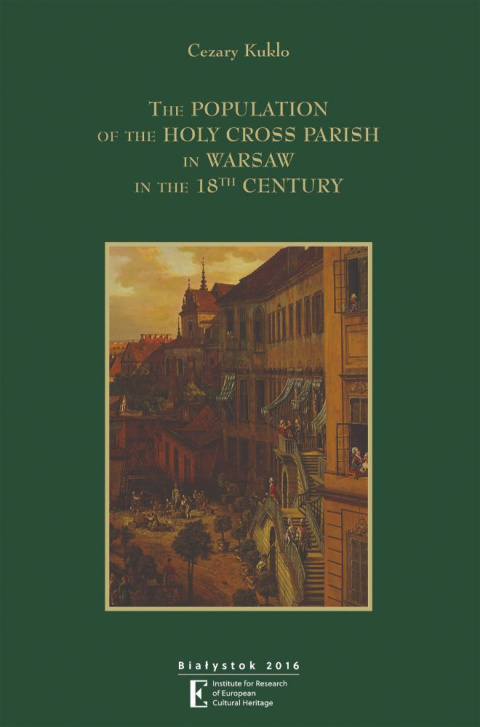-
Koszyk jest pusty
-
x

-
Koszyk jest pusty
-
x
- Kategorie
-
The Population of the Holy Cross Parish in Warsaw in the 18th Century


| Wysyłka w ciągu | 24 godziny |
| Cena przesyłki | 11 |
| Dostępność |
Mała ilość
|
| Kod kreskowy | |
| ISBN | 9788364103063 |
| EAN | 9788364103063 |
| Zostaw telefon |
Autor: Cezary Kuklo
Rok wydania: 2016
Liczba stron: 285
Okładka: twarda
Format: 17,00 cm x 24,00 cm
Seria: Disertationes 14
Even in the first half of the 20 th century historical demographers calculated population but were little interested in the mechanisms of the increase in the number of population or its inhibition in connection with the fundamental factor which was family. Moreover, early studies on the population or its number to be exact, assumed that people multiplied in a natural, unlimited, way, and only numerous diseases, especially mass epidemics, in the face of which Man was helpless, regulated the population. It was only observations in the 20 th century, when mass mortality did not occur, that convinced demographers that the mechanism of population growth depends not only on deceases but also, to at least equal extent, on the number of births or the size and fertility of the family. The dramatic decrease in birthrate in certain countries, especially in Western Europe after World War II, resulted in the shift in research interests and even social policy. Hence the conclusion that in order to understand the ways of growth in population and its inhibition it is not enough to know statistical lists or the range and the impact of epidemics, but it is important to examine the mechanisms regulating fertility, which means the structure and dynamics of the ancient family. In this situation, the family as the smallest social cell wchich maintains the biological continuity of society and passes down the fundamental output of the cultural heritage, became in the second half of the previous century the focal point of various research disciplines, not only demography Or economics but also sociology, pedagogy, law, psychiatry, sexology etc.
(from introduction)
Już w pierwszej połowie XX wieku demografowie historyczni obliczali populację, ale mało interesowali się mechanizmami wzrostu liczebność populacji lub jej zahamowania w związku z podstawowym faktem, którym była rodzina. Ponadto wczesne badania populacji lub jej liczebności zakładały, że ludzie rozmnażają się w sposób naturalny, nieograniczony, tylko liczne choroby, zwłaszcza masowe epidemie, w obliczu których człowiek był bezradny, regulowały populację. Dopiero obserwacje w XX w., kiedy masowa śmiertelność nie występowała, przekonało demografów, że tzw. mechanizm wzrostu populacji zależy nie tylko od zgonów, ale także w najmniej równym stopniu, od liczby urodzeń lub wielkości i dzietności rodziny. Dramatyczny spadek przyrostu naturalnego w niektórych krajach, zwłaszcza zachodnich w Europie po II wojnie światowej, spowodował zmianę zainteresowań badawczych, a nawet polityki socjalnej. Stąd wniosek, że aby zrozumieć sposoby przyrostu ludności i jego zahamowania nie wystarczy znajomość zestawień statystycznych lub zasięgu i wpływu epidemii, ale ważne jest zbadanie mechanizmów regulujących płodność, czyli budowę i dynamikę starożytnej rodziny. W tej sytuacji rodzina jako najmniejsza komórka społeczna, która utrzymuje biologiczną ciągłość społeczeństwa i przekazuje całkowity dorobek dziedzictwa kulturowego stała się w drugiej połowie poprzedniego stulecia centralnym punktem różnych dyscyplin badawczych, nie tylko demografii czy ekonomii, ale także socjologii, pedagogiki, prawa, psychiatrii, seksuologii itp.
(ze wstępu)
Spis treści:
List of tables /9
List of figures /11
List of illustrations /13
Introduction /15
Sources /19
Literature /20
Chapter 1. The value of parish registers and research methodology /29
1. Continuity of preservation, external description and elements of content /29
2. The completeness of registers /33
3. Methodology /41
Chapter 2. Warsaw in the 18th century /49
1. Warsaw on the map of Poland and Central Europe /49
2. The territorial development of the Holy Cross parish by the end of the 18th century /61
3. The parish community /69
4. Demographic structures /78
4.1. Population by sex, age and marital status /78
4.2. Household: structure and size /85
4.3. The place of old people /91
Chapter 3. Nuptiality /95
1. Changes in annual numbers of marriages /95
2. Marriages in the years of natural disasters /102
3. Seasonality of marriages /109
4. Parish compulsion. Mixed marriages. Residence before the marriage /114
4.1. Parish compulsion /114
4.2. Mixed marriages /117
4.3. Residence before the marriage /118
5. Age of the newlyweds /121
6. Marital status of the newlyweds /125
7. Duration of marriages and widowhood /128
Chapter 4. Births /139
1. Changes in annual numbers /139
2. Births during natural disasters /151
3. Seasonality /157
4. The size of the reconstructed families /161
5. Illegitimate births and foundlings /169
Chapter 5. Fertility /185
1. Fertility by marriage age /187
2. Fertility and the duration of marriage /191
3. Premarital conceptions and the protogenetic interval /195
4. Intergenetic intervals /201
5. Did Varsovians practice limitation of births? /206
Chapter 6. Mortality /217
1. Changes in the annual numbers of burials /217
2. Seasonality /229
2.1. Seasonality of deceases during plagues and epidemics /234
3. Mortality of infants and children /236
4. Adult mortality /241
5. Causes of deceases /245
Conclusions /249
Bibliography /255
Name index /277
Place index /283
